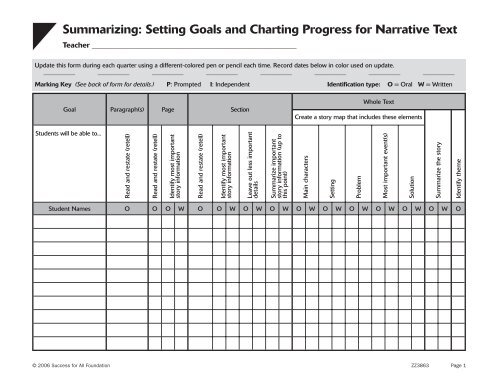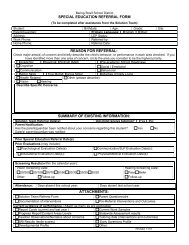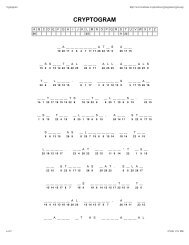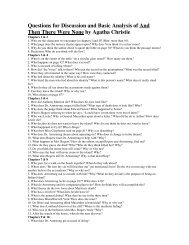Summarizing: Setting Goals and Charting Progress for Narrative Text
Summarizing: Setting Goals and Charting Progress for Narrative Text
Summarizing: Setting Goals and Charting Progress for Narrative Text
You also want an ePaper? Increase the reach of your titles
YUMPU automatically turns print PDFs into web optimized ePapers that Google loves.
<strong>Summarizing</strong>: <strong>Setting</strong> <strong>Goals</strong> <strong>and</strong> <strong>Charting</strong> <strong>Progress</strong> <strong>for</strong> <strong>Narrative</strong> <strong>Text</strong><br />
Teacher ______________________________________________________<br />
Update this <strong>for</strong>m during each quarter using a different-colored pen or pencil each time. Record dates below in color used on update.<br />
__________ __________ __________ __________ __________ __________ __________ __________<br />
Marking Key (See back of <strong>for</strong>m <strong>for</strong> details.) P: Prompted I: Independent Identification type: O = Oral W = Written<br />
Goal Paragraph(s) Page Section<br />
Whole <strong>Text</strong><br />
Create a story map that includes these elements<br />
Students will be able to...<br />
Read <strong>and</strong> restate (retell)<br />
Read <strong>and</strong> restate (retell)<br />
Identify most important<br />
story in<strong>for</strong>mation<br />
Read <strong>and</strong> restate (retell)<br />
Identify most important<br />
story in<strong>for</strong>mation<br />
Leave out less important<br />
details<br />
Summarize important<br />
story in<strong>for</strong>mation (up to<br />
this point)<br />
Main characters<br />
<strong>Setting</strong><br />
Problem<br />
Most important event(s)<br />
Solution<br />
Summarize the story<br />
Identify theme<br />
Student Names O O O W O O W O W O W O W O W O W O W O W O W O<br />
© 2006 Success <strong>for</strong> All Foundation ZZ3863 Page 1
Skills <strong>for</strong> <strong>Summarizing</strong> <strong>Narrative</strong> <strong>Text</strong><br />
Definitions of Skills <strong>and</strong> Criteria <strong>for</strong> Success:<br />
Read <strong>and</strong> restate (Retell what has been read):<br />
The student reads the text <strong>and</strong> restates, in his or her own words, the gist of the text message.<br />
Criteria <strong>for</strong> Success: The student retells most of the important events. With refined use of the skill,<br />
the student’s retellings come closer to including the important ideas related to the story elements<br />
<strong>and</strong> fewer of the less important ideas or details.<br />
Identify the main ideas <strong>and</strong> supporting details (oral <strong>and</strong> written):<br />
The student reads the text <strong>and</strong> discusses, identifies, <strong>and</strong> records the main ideas <strong>and</strong> supporting details<br />
<strong>for</strong> the part that was read. Items may be recorded in note or list <strong>for</strong>m, or on a graphic organizer such as<br />
a story map. This sorting of in<strong>for</strong>mation requires students to make conscious decisions about what is<br />
important <strong>and</strong> what is less important.<br />
Criteria <strong>for</strong> Success: The student correctly identifies <strong>and</strong> organizes most of the story elements<br />
(main characters, setting, story problem, important events, <strong>and</strong> resolution) from the part that was<br />
read, effectively discarding the majority of the less important in<strong>for</strong>mation. With refined use of this<br />
skill, the student successfully identifies <strong>and</strong> records all the important in<strong>for</strong>mation from the part that<br />
was read <strong>and</strong> discards all the less important details.<br />
Create a Story Map (oral or written):<br />
The student creates a graphic organizer of the main ideas from a whole story.<br />
Criteria <strong>for</strong> Success: The student correctly identifies most of the important in<strong>for</strong>mation <strong>for</strong> each<br />
story element from the whole story. With refined use of this skill, the student is able to retell many<br />
ideas, using original language that summarizes the in<strong>for</strong>mation further.<br />
Summarize the text (oral <strong>and</strong> written):<br />
The student uses the main ideas <strong>and</strong> supporting details to develop a clear, concise summary of the original text.<br />
Criteria <strong>for</strong> Success: The student develops an oral or written summary that includes most of the<br />
main ideas <strong>and</strong> supporting details identified on an organizer while reading; the summary is concise,<br />
coherent, <strong>and</strong> connected. With refined use of this skill, the student better identifies important<br />
ideas, subsuming related ideas into concepts, deleting more extraneous in<strong>for</strong>mation. The summary<br />
demonstrates higher-order thinking <strong>and</strong> more original language to express the important ideas.<br />
Identify the theme:<br />
If appropriate <strong>for</strong> the text, the student uses recurring, important in<strong>for</strong>mation to determine the theme<br />
(lessons or morals that give greater meaning to the story).<br />
Criteria <strong>for</strong> Success: The student can tell the theme or moral of a story (what was learned,<br />
what the story teaches). With refined use of this skill, the student can explain what parts of the<br />
story exemplify theme <strong>and</strong> how.<br />
To Record <strong>Progress</strong>:<br />
1. Observe <strong>and</strong> record successful<br />
use of each skill as follows (focus<br />
observations in the order listed,<br />
observing <strong>for</strong> “Prompted” first):<br />
P: Prompted—The student uses<br />
this skill when reminded or<br />
with suggestions <strong>and</strong> coaching.<br />
If the student uses the skill<br />
independently <strong>and</strong> never<br />
requires prompting, award<br />
the point.<br />
I: Independent—The student<br />
uses this skill independently,<br />
without reminders, suggestions,<br />
or coaching.<br />
2. For quarterly assessments of<br />
progress, count the total number<br />
of letters <strong>for</strong> each student. Record<br />
this number as a fraction of 48,<br />
the total possible letters a student<br />
may earn. Example: If student has<br />
14 marks, the quarterly progress<br />
record is: 14/48.<br />
© 2006 Success <strong>for</strong> All Foundation ZZ3863 Page 2
















